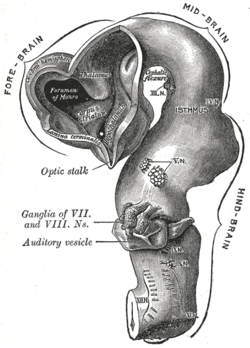Flexure (embryology)
| Flexures | |
|---|---|
 Brain of human embryo of four and a half weeks, showing the three flexures | |
| Details | |
| Identifiers | |
| Latin | flexura |
| TE | (embryology)_by_E5.14.3.3.0.0.3 E5.14.3.3.0.0.3 |
| Anatomical terminology | |
Three flexures form in the part of the
Flexure development
The neural tube has a longitudinal axis called the neuraxis, from the future brain area at the cranial end, to the conus medullaris of the spinal cord at the caudal end. By the fourth week in the human embryo, at its cranial end, three swellings have formed as primary brain vesicles.[1] These vesicles form the future forebrain, midbrain, and hindbrain. The three vesicles need to develop further into five brain vesicles but the space at the cranial end is limited. This causes the neural tube to bend ventrally at two flexures – the first at the cephalic flexure and the second at the cervical flexure. A third flexure is oriented in the opposite dorsal direction as the pontine flexure. By the fifth week further flexion has taken place and the five secondary brain vesicles have formed.[1]
The angle formed by the two ventral flexures, the cephalic flexure and the cervical flexure together, is a right angle in the ventral direction between the axis of the body and the axis of the brain. The pontine flexure is located between these two flexures.

Cephalic flexure
The cephalic flexure, also known as the mesencephalic flexure, is the first flexure or bend, that forms in the region of midbrain.[2] The caudal part of the midbrain and the rostral part of the hindbrain makes up a mibrain-hindbrain boundary region known as the isthmic organizer.[3] In human embryos it generally occurs at the end of the 3rd week or the beginning of the 4th.
Cervical flexure
The cervical flexure forms between the hindbrain and the spinal cord.[4]
Pontine flexure
The pontine flexure, also called the rhombic flexure, forms the boundary between the metencephalon and the myelencephalon.[5][6][7] The metencephalon becomes the pons and the cerebellum, and the myelencephalon becomes the medulla oblongata. These two regions develop and fold dorsally at the pontine flexure.[5]
References
- ^ ISBN 9780071222075.
- PMID 32809424, retrieved 2022-09-02
- ISBN 9780123694973.
- ^ "Cervical flexure". braininfo.rprc.washington.edu.
- ^ ISBN 9780781790697.
- ^ "Pontine flexure". braininfo.rprc.washington.edu.
- PMID 26246090.
